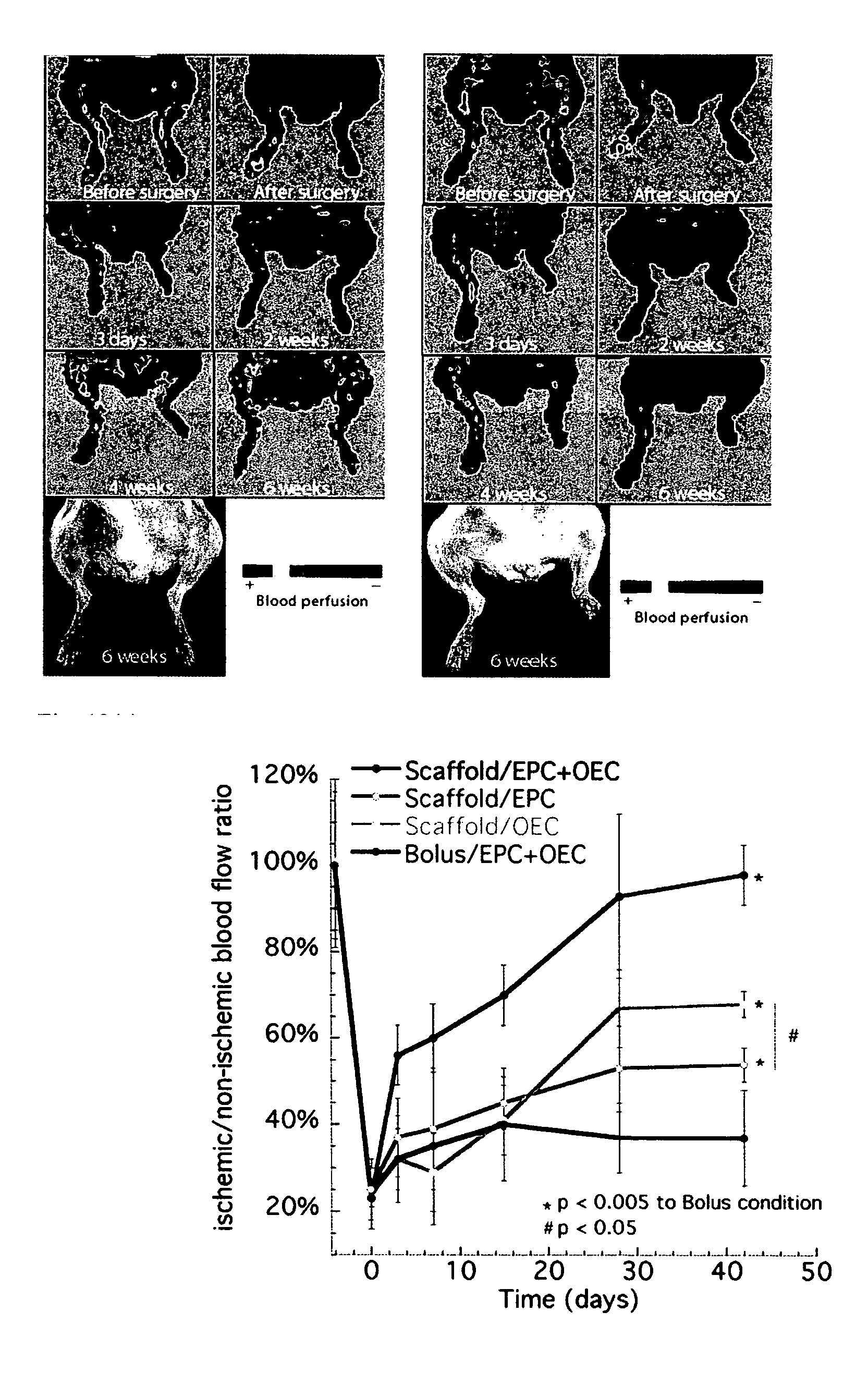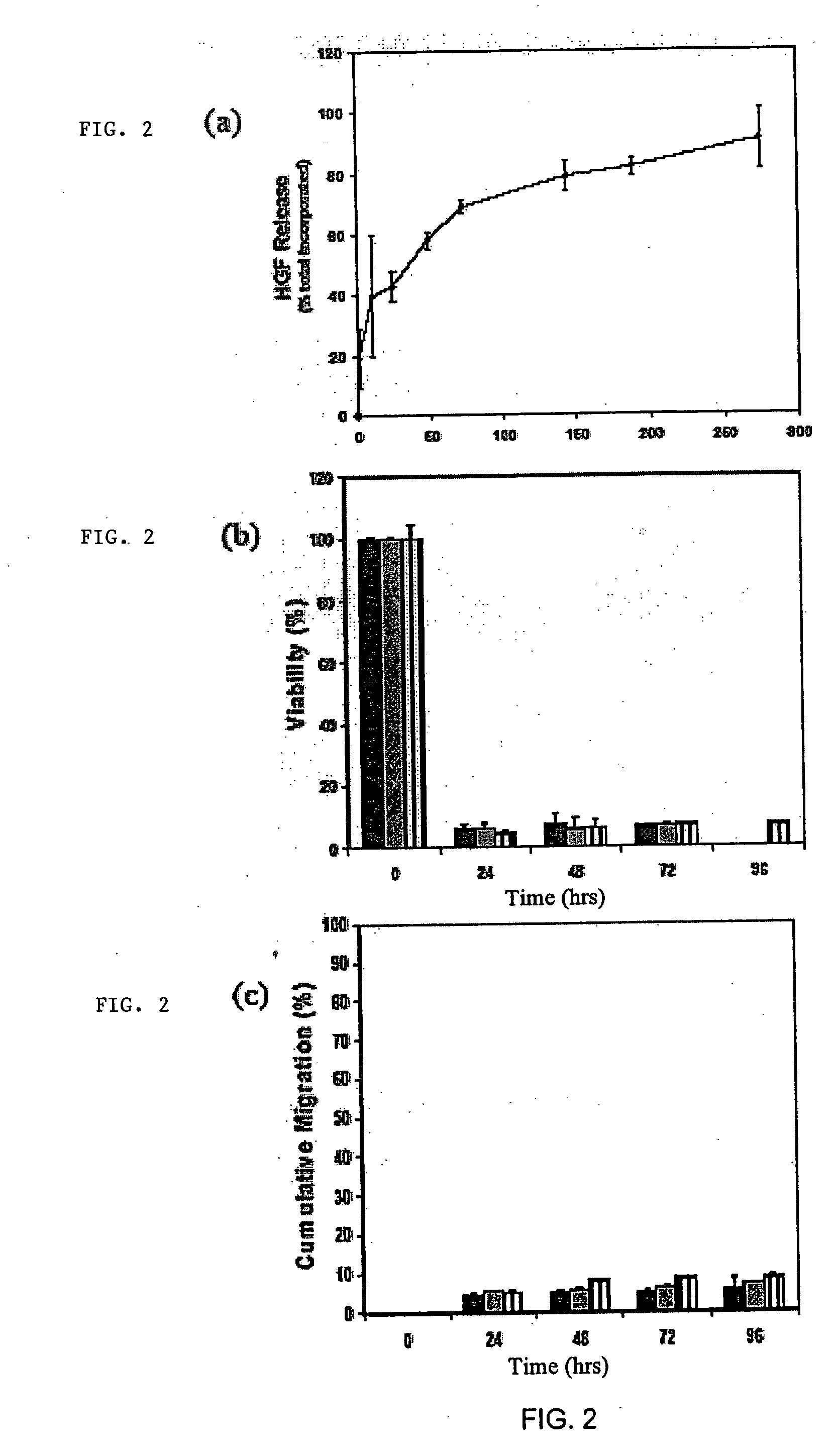Scaffolds for cell transplantation
a cell transplantation and scaffolding technology, applied in the field of scaffolds for cell transplantation, can solve the problems of limited success of cell transplantation in musculoskeletal regenerative medicine, net loss of muscle mass and resulting strength, and so as to promote cell-based maintenance of tissue structure and function, promote cell-based migration, and promote the effect of tissue destruction
- Summary
- Abstract
- Description
- Claims
- Application Information
AI Technical Summary
Benefits of technology
Problems solved by technology
Method used
Image
Examples
example 2
Niche Scaffolds Promote Muscle Regeneration using Transplanted Cells
[0133] Transplanting myoblasts within synthetic niches that maintain viability, prevent terminal differentiation, and promote outward migration significantly enhances their repopulation and regeneration of damaged host muscle. Myoblasts were expanded in culture, and delivered to tibialis anterior muscle laceration sites in mice by direct injection into muscle, transplantation on a macroporous delivery vehicle releasing factors that induce myoblast activation and migration (HGF and FGF), or transplantation on materials lacking factor release. Controls included the implantation of blank scaffolds, and scaffolds releasing factors without cells. Injected cells in the absence of a scaffold demonstrated a limited repopulation of damaged muscle, and led to a slight improvement in muscle regeneration. Delivery of cells on scaffolds that did not promote migration resulted in no improvement in muscle regeneration. Strikingly...
example 3
Treatment Skin Wounds
[0152] In the context of a skin defect, the goals of the therapy are dictated by the type of wound (e.g., acute bum, revision of scar, or chronic ulcer) and size of the wound. In the case of a small chronic ulcer, the objective is closure of the wound by regeneration of the dermis. The epidermis regenerates via migration of host keratinocytes from the adjacent epidermis. For large wounds, keratinocytes, optimally autologous, are provided by the device to promote regeneration of the epidermis. Cells are loaded into a scaffold material that is placed directly over the wound site, e.g., a scaffold structure in the form of a bandage. The material provides a stream of appropriate cells to promote regeneration. For dermal regeneration, fibroblasts cells are used to seed the device, and these cells are either autologous (biopsy taken from another location and expanded before transplantation) or allogeneic. Advantages of autologous cells include a decreased risk of dis...
example 4
Devices and Systems for Promoting Angiogenesis
[0155] Angiogenesis is a critical element in any tissue regeneration effort, and the temporally distinct signaling of vascular endothelial growth factor (VEGF) is crucial in this process. Devices that contain compositions which promote angiogenesis together with endothelial cells resulted in a synergistic angiogenic effect. The approach utilizes cells that play a role in the angiogenic process, e.g., endothelial progenitor cells and outgrowth endothelial cells (e.g., derived from cord blood or from peripheral blood samples).
[0156] An injectable alginate hydrogel was developed to provide spatial distribution and temporal control of factors inducing neovascularization of hypoxic tissues. The hindlimbs of C57BL / 6J mice were made ischemic by femoral artery and vein ligation, and the hydrogel containing growth factors was directly injected into the ischemic muscle (bolus delivery of VEGF was used as a control), and the in vivo release kinet...
PUM
| Property | Measurement | Unit |
|---|---|---|
| pore size | aaaaa | aaaaa |
| diameter | aaaaa | aaaaa |
| diameter | aaaaa | aaaaa |
Abstract
Description
Claims
Application Information
 Login to View More
Login to View More - R&D
- Intellectual Property
- Life Sciences
- Materials
- Tech Scout
- Unparalleled Data Quality
- Higher Quality Content
- 60% Fewer Hallucinations
Browse by: Latest US Patents, China's latest patents, Technical Efficacy Thesaurus, Application Domain, Technology Topic, Popular Technical Reports.
© 2025 PatSnap. All rights reserved.Legal|Privacy policy|Modern Slavery Act Transparency Statement|Sitemap|About US| Contact US: help@patsnap.com



